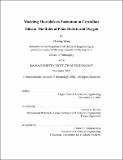| dc.contributor.advisor | Robert A. Brown. | en_US |
| dc.contributor.author | Wang, Zhihong, 1972- | en_US |
| dc.contributor.other | Massachusetts Institute of Technology. Dept. of Chemical Engineering. | en_US |
| dc.date.accessioned | 2005-05-19T15:14:03Z | |
| dc.date.available | 2005-05-19T15:14:03Z | |
| dc.date.copyright | 2002 | en_US |
| dc.date.issued | 2003 | en_US |
| dc.identifier.uri | http://hdl.handle.net/1721.1/16905 | |
| dc.description | Thesis (Ph. D.)--Massachusetts Institute of Technology, Dept. of Chemical Engineering, February 2003. | en_US |
| dc.description | Includes bibliographical references (p. 225-233). | en_US |
| dc.description | This electronic version was submitted by the student author. The certified thesis is available in the Institute Archives and Special Collections. | en_US |
| dc.description.abstract | Most microelectronic devices are fabricated on single crystalline silicon substrates that are grown from the melt by the Czochralski crystal growth method. There is an ever increasing demand for control of size and density of microdefects in the silicon for control of quality and uniformity of the fabricated microelectronic devices. This thesis is aimed at developing a fundamental understanding of the mechanisms for formation of such microdefects through the development of models, theoretical analysis and large-scale simulation. Two major problems have been addressed. First, following the work of T. Sinno [150] and T. Mori [108], models have been developed for the transport, reaction and aggregation of native point defects - self-interstitials ('s) and vacancies (V's) - in crystalline silicon, so as to explain the dynamics of void formation (aggregation of V's) and stacking faults (aggregation of I's). Second, the model of point defect and cluster dynamics has been extended to include oxygen, the most common impurity in silicon, and to model oxide precipitation, an important step in silicon wafer preparation and device processing. The models of microdefect formation begin with transport equations for native point defects that include transport by diffusion and convection (crystal motion), recombination of Is and Vs, and the loss of point defects to clusters. Cluster formation is modeled by a combination of discrete rate equations for small-sized clusters (less than 100) and continuous Fokker-Planck equations for large cluster sizes. Simulation methods are developed for calculating, in time, space and cluster size, the evolution of point defect and cluster profiles, as a function of the temperature distribution in the crystal. | en_US |
| dc.description.abstract | (cont.) Considerable effort has been devoted to analysis of the critical operating conditions that divide the crystal into V-rich and I-rich regions. As analyzed by Sinno [151], these radial regions of a CZ-grown silicon crystal are distinguished by a critical value of V/G=(V/G)crit, where V is the crystal pull rate and G is a measure of the axial temperature gradient at the melt/crystal interface. Numerical simulations identify that the evolution of microdefects at an axial slice of the crystal can be divided into three regions: (1) the region of rapid point defect dynamics near the melt-crystal interface, (2) a region of intermediate point defect concentrations where the crystal to too hot for these concentrations to become super-saturated, and (3) the nucleation and growth of point defect clusters caused by homogeneous nucleation and super-saturation. Asymptotic analysis of void formation is carried out in each of these regions and linked by point defect conservation to give predictions for a number of very important values, including (V/G)crit, the intermediate vacancy concentration, the void nucleation temperature, the total void concentration in the crystal and the average void size. These results agree remarkably well with simulations. Moreover, the asymptotic results give the foundation for creating a simple simulation tool for prediction of the dependence of these parameters on operating conditions. The framework for microdefect formation is extended to oxygen precipitation by including oxygen dynamics and precipitation ... | en_US |
| dc.description.statementofresponsibility | by Zhihong Wang. | en_US |
| dc.format.extent | 233 p. | en_US |
| dc.format.extent | 2695559 bytes | |
| dc.format.extent | 2693280 bytes | |
| dc.format.mimetype | application/pdf | |
| dc.format.mimetype | application/pdf | |
| dc.language.iso | eng | en_US |
| dc.publisher | Massachusetts Institute of Technology | en_US |
| dc.rights | M.I.T. theses are protected by copyright. They may be viewed from this source for any purpose, but reproduction or distribution in any format is prohibited without written permission. See provided URL for inquiries about permission. | en_US |
| dc.rights.uri | http://dspace.mit.edu/handle/1721.1/7582 | |
| dc.subject | Chemical Engineering. | en_US |
| dc.title | Modeling microdefects formation in crystalline silicon : the roles of point defects and oxygen | en_US |
| dc.type | Thesis | en_US |
| dc.description.degree | Ph.D. | en_US |
| dc.contributor.department | Massachusetts Institute of Technology. Department of Chemical Engineering | |
| dc.identifier.oclc | 52298371 | en_US |
